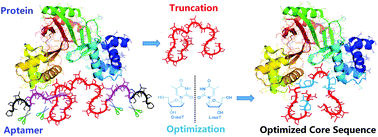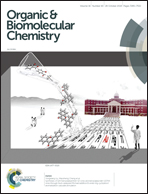d-/l-Isothymidine incorporation in the core sequence of aptamer BC15 enhanced its binding affinity to the hnRNP A1 protein†
Abstract
The heterogeneous nuclear ribonucleoprotein A1 (hnRNP A1) was reported to participate in the development of a variety of tumors. BC15 is a DNA aptamer targeting hnRNP A1. Firstly, through sequence truncation, we identified 31-mer sequence BC15–31 as the core sequence of BC15 with a strong binding affinity and high selectivity to the hnRNP A1 protein. Isothymidine (isoT) modification was then applied for the structural optimization of BC15–31, systematic modification and biological evaluation were carried out. Incorporation of isoT in the 1,3 sites at the 5′-end of BC15–31 can significantly enhance the protein affinity. Chemical modifications close to the 3′-end can greatly improve the stability of the aptamer. Furthermore, BC15–31 modified with isoT at both the 5′-end and 3′-end displayed an additive effect with enhanced bioactivity and stability at the same time. Our study strategy on BC15 provides a useful guideline for chemical modification and optimization of the aptamer for further clinical application.

- This article is part of the themed collection: Chemical Biology in OBC


 Please wait while we load your content...
Please wait while we load your content...